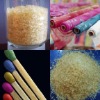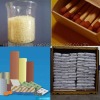- Kidney Beans[1]
- Vigna Beans[1]
- Coats[2]
- Vests & Waistcoats[1]
- Adhesives & Sealants[1]
- Other Organic Chemical[1]
- Chemical Auxiliary Agent[4]
- Food Additives[5]
- Winter Hats[1]
- Fur Scarves[2]
- Packaging Machinery[6]
- Printing Machinery[5]
- Animal Fur[4]
- Contact Person : Ms. Yang Sunny
- Company Name : Hebei Fucheng Import & Export Co.
- Tel : 86-318-8071519
- Fax : 86-318-5235766
- Address : Hebei,hengshui,EAST GATE OUT STREET, FUCHENG COUNTY
- Country/Region : China
- Zip : 053000
Related Product Searches:Gelatin,High Quality,Gelatin, edible gelatin,FC-001
Gelatin is manufactured in modern factory which is operated to the highest health and safety standards.
The raw material for gelatin manufacture is the naturally occurring protein collagen, which is commercially sourced from the meat industry. Each stage of the manufacturing process is rigorously controlled in modern laboratories to ensure purity and quality. The process of converting collagen into gelatin involves several cleansing and purification steps and the end result is a pale yellow dry powder which is a true foodstuff.
Gelatin contains:
84-90% protein
1-2% mineral salts
8-15% water
Gelatin is pure and natural
Commercial gelatin is manufactured in modern factories operated to the highest health and safety standards.
Gelatin is a high-grade protein
We cannot exist without protein, therefore edible gelatin - a pure and easily digestible protein - is a particularly important part of our diet. Other nutrients, such as fats and carbohydrates, can often substitute each other in human metabolism, but protein can rarely, if ever, be substituted and a regular intake is essential for our health and well being.
Proteins are many and varied but are not all equal in their nutritional value.
Proteins are based on amino-acids
The building blocks of the various types of protein are amino acids. Our body is capable of building the proteins it requires from amino acids and to some extent is also capable of creating amino acids from digestive fragments. This is not true of all amino acid types, which means that we must eat ten essential amino acids regularly in our food. Edible gelatin contains nine of these essential amino acids.
Gelatin structures
Gelatin contains specific amounts of 18 different amino acids (AA) which are joined together in sequences to form polypeptide chains of ca. 1000 AA per chain, scientifically known as the primary structure. Three of the polypeptide chains formed this way join together as a left-hand spiral to give the secondary structure. In the tertiary structure, the spiral winds and folds itself to a right-hand spiral (triple helix). This results in a rod-shaped molecule, the so-called proto fibril.
Quality characteristics
Several types of edible gelatin are available with varying characteristics depending on the application and end product. Edible gelatin is a foodstuff and must satisfy strict purity regulations. An important element in determining the quality of gelatin is the firmness or strength of the set gel. This is characterized by the "Bloom" value. The viscosity of solution is also an important factor in manufacturing processes such as for wine gums or "gummi bears" where gelatins with a low viscosity are used to prevent "tailing" (molding deposits). The setting point indicates the temperature at which a 10% aqueous gelatin solution gels. For photographic, pharmaceutical, toiletries and technical applications, other characteristics are important.
The best way to dissolve gelatin powder is to soak it in cold water for a short time and then gently warm the water until the gelatin has melted.
Other types such as leaf gelatin can be simply added to the recipe and allowed to absorb liquid during cooling.
Instant gelatins are available as powders, which do not need heating or "soaking" time. These are used for stabilizing foods such as gateaux or desserts.
Production Process
Pre-treatment
First of all, the fat and minerals are removed from the raw materials. Afterwards two different pre-treatment methods are used, depending on the raw material and on the final application of the gelatine.
Alkaline procedureThe connective tissue of cattle is highly interconnected and is therefore pre-treated with lime in a process lasting several weeks. This brings about a gentle change to the collagen structure. After this treatment, the collagen is soluble in warm water and can thus be separated from the rest of the raw material.
Acid procedureThe collagen connective tissue from pigskin is not so heavily interconnected. Here, a one-day acid treatment with subsequent neutralization and the intensive rinsing out of the salts is sufficient to extract the collagen.
Extraction
The pre-treated raw materials are now treated with hot drinking water and extracted in several stages. The temperature of the hot water is a parameter for the jelly strength: the lower the temperature of the water, the higher the gel strength (bloom value) of the extracted gelatine.
Cleaning
The extracted solutions are freed of traces of fat and fine fibres in high-performance separators. Even the finest impurities are removed by filtration, in a similar way to the beverages industry. In a last purification stage the gelatine is freed of calcium, sodium, residual acid and other salts.
Thickening
The gelatine solution is now concentrated in vacuum evaporators and thickened to form a honey-like solution.
Drying
The highly concentrated gelatine solutions are sterilized, cooled, set and dried under strict hygienic conditions. In this process, “gel noodles” are formed that are ground into grains when dry.
The quality and purity of the gelatine is ensured by detailed quality control.All of these steps are indispensable for gelatine manufacture and have been used for decades to manufacture high-quality gelatine.
Gelatin






